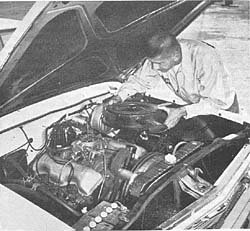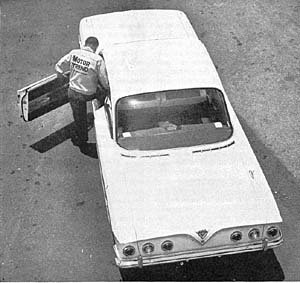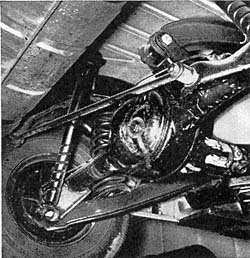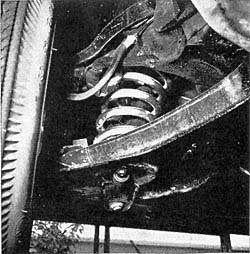 | 
|
Put the big 409-cubic-inch engine into the new Super Sport package and you have one of the hottest test cars of the season. MT checks it out from its design features to its drag strip potential |
 | 
|
Put the big 409-cubic-inch engine into the new Super Sport package and you have one of the hottest test cars of the season. MT checks it out from its design features to its drag strip potential |
| FAMILY CAR that is really a racing
machine probably best describes Chevrolet's latest contribution to the high-performance field. Though some family men may drive 409 Super Sports to and from work, the car admittedly wasn't built for this purpose; however, such use will help qualify it for an important purpose, NASCAR racing.
NASCAR, the sanctioning body that formulates the rules governing stock car racing, is partially responsible for the form of the "409" we tested. One of the prime limitations this association imposes explains the use of a single four-barrel carburetor instead of a more exotic layout. For this reason, the casual observer would see nothing unusual about the engine compartment. Most people would just assume that it was a conventional 348-cubic-inch engine. Externally, the only clues to the character of this car are three little double-S medallions, one on the skirt of each rear fender and one near the keyhole of the deck lid. Except for these labels, our impala test car looked like any other |
| rendering of Chevrolet's classy-looking two-door hardtop. The well-appointed interior even lacks clues that could reveal its true nature. A back seat passenger actually sees nothing abnormal unless he leans forward and peers into the cockpit. A floor-mounted four-speed gearshift lever and a steering-column-mounted tachometer are the only evidence of what lies forward of the firewall.
The existence of a standard 120-mph speedometer, a conventional Chevrolet instrument, seems anomalous since the vehicle is capable of "pegging" the meter. This is really quite a turnabout, because most meters exaggerate the capacity of the vehicles they adorn. |  |
| A definite deficiency in the instrument department is the lack of an oil pressure gauge. It is doubtful that many drivers will want to race one of these machines on an oval track with nothing but a red warning light to tell whether the oil pump is doing its job.
Since high-speed track racing is the incentive behind the creation of the "409," the rear end gear ratio on delivery is 3.36-to-1. This gear-set is not best for 1/4-mile drag racing, so after thoroughly testing the car with the as-delivered ring and pinion, the ratio was changed to 4.56-to-1, and another complete test was run. Anyone intent on buying a "409" Super Sport for drag racing must be prepared to make a gear swap after the car is delivered. They cannot be ordered from the factory with anything but the 3.36-to-1 gears. Over 500 miles of driving with each gear-set demonstrated quite graphically that the numerically smaller ratio can be quite satisfactory unless ultimate performance is desired. The man who's buying a high-performance family car will be much happier with this ratio. The larger ratio, except when used at the drag strip, only succeeds in "splitting hairs." Of course, dropping the 0-to-60 time from 7.8 to 7 seconds flat will probably be considered a rather "wide hair" by some enthusiasts. Our test showed a whole second faster in the 0-to-45 range with a 5.8 versus a 4.8 second time for the 4.56's. |
| Rear suspension is fitted with extra-long, heavy-duty shock absorbers and stiffer police-option springs. |  |
 |
Front suspension also uses higher-rate springs and heavy-duty shocks from police running gear kit. |
| The comparative acceleration times, though interesting, are not a true yardstick with which to compare the merits of the gear switch. When tested with the standard rear end, the low initial torque
of this engine coupled with the 2.54-to-1 first gear ratio caused the engine to actually bog down after the clutch was engaged. At the other extreme, with the clutch engaged and the car idling along at 15 mph in first gear, the 4.56's were responsible for wheel spin when the throttle was floored. If special tires instead of the stock low-profile 8:00 x 14's had been used, there would have been a startling difference in performance.
When appraising the car's personality with the two sets of gears, it is necessary to go a bit further than acceleration characteristics. This became very apparent after the 3.36's were removed. Before the gear switch, highway and freeway driving, in addition to appearing seemingly effortless, provided an engine noise level so low that it compared favorably with a conventional machine. Engine noise only became apparent when adjacent to a reflecting surface. The higher engine rpm's resulting from the gear switch increased the amplitude of the engine's many noises to such a degree that drivers often checked the gearshift lever to make sure it was in fourth instead of third. Though the 4.56's may have been slightly annoying while cruising at highway speeds, they did make the car easier to drive in traffic by making it unnecessary to shift as often. In order to fully understand why less gear changing was necessary, we must look at the valve timing for a moment. The cam that appears in the "409" is the most radical of any appearing in a Chevrolet product -- it has an overlap duration of 85 degrees. The intake valve actually opens 59 degrees before the piston finishes the exhaust stroke, and the exhaust valve closes 26 degrees after top dead center. Keeping these two valves open simultaneously for so long a period of time causes considerable exhaust dilution of the fresh charges entering the cylinders at partial throttle, so a slow idle is impossible. Although the engine will idle at 750 rpm, it will not pull smoothly under 1500 and is "happiest" when operated over 2,000 rpm. When viewing the fuel consumption figures obtained during the test, we again find that a relationship between cam timing and the gearshift lever must be considered. Due to the engine's reluctance to operate at low rpm, the transmission was operated in the lower gears while negotiating traffic. While the 3.36-to-1 rear end was used, the car couldn't be driven in fourth gear unless a speed of more than 40 mph was maintained. However, since a little more than half of the driving was on the freeways, which allowed the continual use of fourth gear, the lower engine rpm resulting from the smaller rear end ratio produced slightly better gas mileage - 10.7 mpg versus 9.6. |